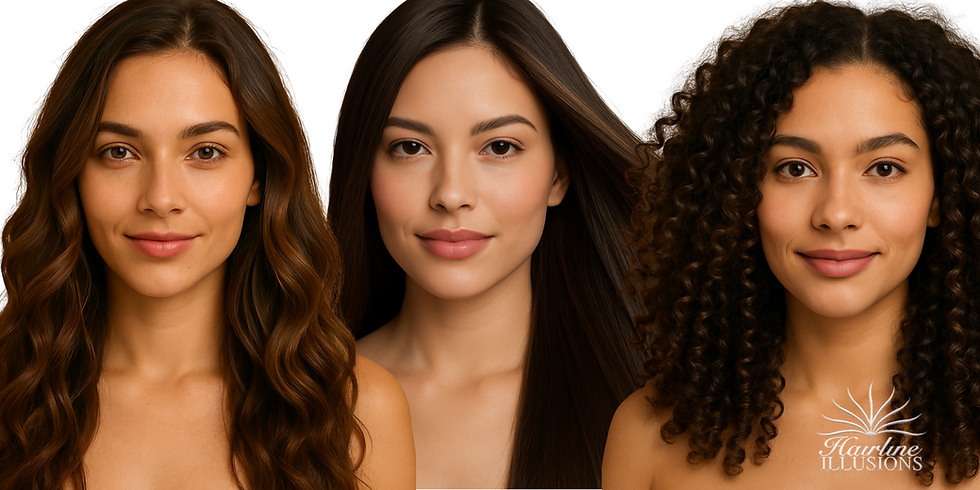Virgin Hair and Hair Texture ➰ Understanding Natural Hair Characteristics
- Hairline Illusions

- Aug 28
- 3 min read

What is Virgin Hair?
Virgin hair refers to human hair that has never been chemically processed, colored, bleached, permed, or treated with any chemical substances. This hair maintains its natural cuticle structure and has not been exposed to heat damage or harsh treatments.
Virgin Hair Texture Facts
Initial Roughness is Normal
Virgin hair often feels rougher to the touch compared to processed hair extensions found in retail stores. Some people may wonder why it feels “rough,” but in reality, virgin hair simply feels more textured or less slippery because the cuticle hasn’t been artificially sealed or coated.
This sensation occurs because:
The natural cuticle layers remain intact and unaltered
No artificial silicones or conditioning agents have been applied
The hair retains its original texture without chemical smoothing
Natural oils and moisture levels vary depending on the donor's hair health
Health vs. Feel
Even though virgin hair can feel rougher at first, it represents the healthiest possible hair condition because:
The hair shaft structure remains completely intact
Natural protein bonds have not been compromised
The cuticle provides maximum protection to the inner cortex
No chemical damage has weakened the hair fiber
So while processed hair may feel “silkier” to the touch, virgin hair has the true advantage of strength and longevity.
Hair Texture Classifications
Coarse Hair Characteristics
Coarse hair has the largest diameter among hair types, typically measuring 70–100 micrometers. Key facts include:
Contains more protein layers in the cortex
Has a thicker cuticle with more overlapping scales
Naturally feels less smooth than medium or fine hair
Provides greater strength and resistance to breakage
Appears fuller and more voluminous
Thick vs. Dense Hair
Thick hair = diameter of individual strands
Dense hair = number of hairs per square inch on the scalp
Both affect how hair feels and looks, but they’re separate characteristics.
Why Coarse Hair Feels Less Soft
Structural Differences
The larger diameter of coarse hair changes how it feels:
More surface area means more friction against fingers
Thicker cuticle layers create a less smooth surface
Greater protein content makes strands feel firmer
Light reflects differently, which can affect visual softness
Natural Variation
Hair texture also varies significantly among individuals and ethnic backgrounds:
Asian hair is typically the coarsest, measuring 80–120 micrometers
Caucasian hair ranges from 50–100 micrometers
African hair, while often fine in diameter (~40–80 micrometers), has unique structural features — an elliptical cross-section, fewer cuticle layers, and tight curl patterns — making it feel different to the touch
Processing vs. Natural Texture
Why Processed Hair Feels Softer
Commercial hair extensions often feel softer right away because:
Chemical processing opens and smooths the cuticle
Silicone coatings add artificial slip and shine
Bleaching and coloring alter the natural protein structure
Repeated treatments condition and coat the surface
The Trade-Off
This softer feel comes at a cost:
Reduced overall strength and integrity
Weakened ability to retain natural moisture
Shorter lifespan and durability
Higher susceptibility to further damage
Conditioning Virgin Hair
Proper Conditioning Process
Virgin hair responds very well to the right treatments:
Natural oils can penetrate the intact cuticle effectively
Protein treatments strengthen the existing structure
Moisture treatments improve flexibility and softness
Regular conditioning enhances natural characteristics
Timeline for Softness
With proper care, virgin hair usually becomes noticeably softer within:
2–3 washes with appropriate conditioning
1–2 weeks of consistent natural oil or moisture treatments
Ongoing styling sessions when using heat protectants
Quality Indicators
Signs of high-quality virgin hair include:
Consistent color from root to tip
Natural variation in texture along the strand
Intact cuticles that lie flat when wet
Ability to hold curls and styles effectively
Gradual softening and improved feel with care
Misconceptions About Texture
Rough feeling does not indicate poor quality — it means the cuticle is intact.
Softness is not always a sign of health — it may be the result of coatings or chemical treatments.
Natural variation is normal — every donor has unique hair texture.
Processing history affects the feel of hair more than its true quality.
Care Recommendations
For Coarse Virgin Hair
Use protein–moisture balanced treatments
Apply natural oils to mid-length and ends
Avoid over-processing with heat or chemicals
Use wide-tooth combs to prevent breakage
For All Virgin Hair Types
Start with gentle, sulfate-free cleansing
Apply leave-in conditioning treatments
Protect from environmental damage (sun, chlorine, pollution)
Allow natural texture to shine with consistent care
Final Takeaway
Virgin hair may feel rougher or more textured at first, but this is a sign of authenticity, not poor quality. With proper care, its natural strength, resilience, and beauty emerge over time — offering healthier, longer-lasting results than chemically processed alternatives.
©2025 Hairline Illusions™




Comments